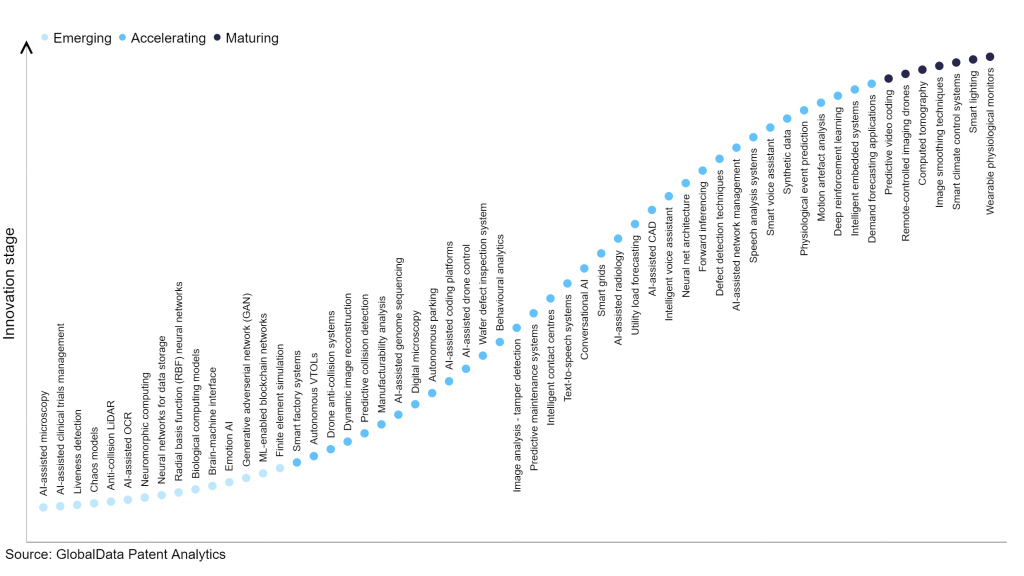The technology industry continues to be a hotbed of innovation, with activity driven by the increasing complexity of products, the need for faster time-to-market, and the demand for quality control and process optimisation, as well as growing importance of technologies such as machine learning, computer vision, predictive analytics, and digital twin simulations, which enable manufacturers to make data-driven decisions and streamline their operations. In the last three years alone, there have been over 3.6 million patents filed and granted in the technology industry, according to GlobalData’s report on Innovation in Artificial Intelligence: Manufacturability analysis. Buy the report here.
However, not all innovations are equal and nor do they follow a constant upward trend. Instead, their evolution takes the form of an S-shaped curve that reflects their typical lifecycle from early emergence to accelerating adoption, before finally stabilising and reaching maturity.
Identifying where a particular innovation is on this journey, especially those that are in the emerging and accelerating stages, is essential for understanding their current level of adoption and the likely future trajectory and impact they will have.
300+ innovations will shape the technology industry
According to GlobalData’s Technology Foresights, which plots the S-curve for the technology industry using innovation intensity models built on over 2.5 million patents, there are 300+ innovation areas that will shape the future of the industry.
Within the emerging innovation stage, finite element simulation, ML-enabled blockchain networks and generative adversarial network (GAN), are disruptive technologies that are in the early stages of application and should be tracked closely. Demand forecasting applications, intelligent embedded systems, and deep reinforcement learning are some of the accelerating innovation areas, where adoption has been steadily increasing. Among maturing innovation areas are wearable physiological monitors and smart lighting, which are now well established in the industry.
Innovation S-curve for artificial intelligence in the technology industry

Manufacturability analysis is a key innovation area in artificial intelligence
Manufacturability analysis involves the evaluation of a product's design to assess its suitability for efficient and cost-effective manufacturing. The process includes examining the impact of design choices on factors such as production costs, quality, and efficiency. By conducting a thorough manufacturability analysis, potential issues and challenges in the manufacturing process can be identified and addressed early on, reducing costs and time-to-market. The ultimate aim is to optimise the design for manufacturability, ensuring it is both cost-effective and capable of achieving high-quality production results.
GlobalData’s analysis also uncovers the companies at the forefront of each innovation area and assesses the potential reach and impact of their patenting activity across different applications and geographies. According to GlobalData, there are 100+ companies, spanning technology vendors, established technology companies, and up-and-coming start-ups engaged in the development and application of manufacturability analysis.
Key players in manufacturability analysis – a disruptive innovation in the technology industry
‘Application diversity’ measures the number of different applications identified for each relevant patent and broadly splits companies into either ‘niche’ or ‘diversified’ innovators.
‘Geographic reach’ refers to the number of different countries each relevant patent is registered in and reflects the breadth of geographic application intended, ranging from ‘global’ to ‘local’.
Patent volumes related to manufacturability analysis
Source: GlobalData Patent Analytics
Taiwan Semiconductor Manufacturing is a leading patent filer in the field of manufacturability analysis. O One of the company’s patents describes a method performed by a processor for modifying a circuit cell layout. The method involves analysing the allocation of specific layout segments, determining if certain segments are coupled to a first signal level, and merging those segments into a merged layout segment when they are coupled to the first signal level.
Other prominent patent filers in the space include Siemens and Global Foundries.
By geographic reach, Phidias Technologies leads the pack, followed by Tela Innovations and TactoTek. In terms of application diversity, Seiko Epson holds the top position, followed by Walmart and ArcelorMittal.
Manufacturability analysis plays a crucial role in improving product design, streamlining manufacturing processes, and driving innovation in the manufacturing industry. It enables manufacturers to optimise their product designs for cost-effectiveness, efficiency, and quality, by identifying areas for improvement. AI-powered manufacturability analysis helps reduce production costs, minimise production errors, and enhance overall productivity. It also enables faster decision-making and enhances collaboration between design and manufacturing teams. To further understand how artificial intelligence is disrupting the technology industry, access GlobalData’s latest thematic research report on Artificial Intelligence (AI) – Thematic Intelligence.
Data Insights
From

The gold standard of business intelligence.
Blending expert knowledge with cutting-edge technology, GlobalData’s unrivalled proprietary data will enable you to decode what’s happening in your market. You can make better informed decisions and gain a future-proof advantage over your competitors.







